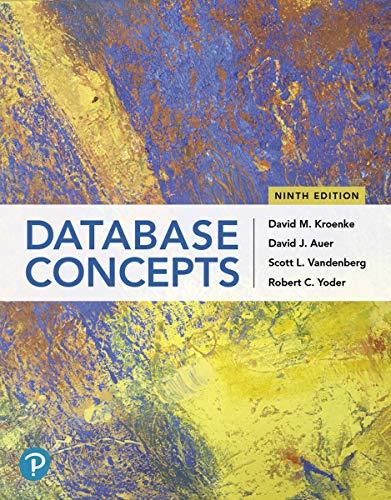Question
INSTRUCTIONS: 1. Adapt the DoTable.cpp program to utilize double variable types for the recip and sum variables instead of floats. Call your new program source
INSTRUCTIONS:
1. Adapt the DoTable.cpp program to utilize double variable types for the recip and sum variables instead of floats. Call your new program source file Lab05.cpp .
(a) Note, youll have to carefully examine the code to use a double cast where appropriate.
(b) The symbol DBL DIG (found in cfloat) describes the number of dependable decimal digits in a double.
(c) The formatting constants used to build the display table will require some modification in order to allow for viewing the full extent of the digits of precision available. Spend some time to produce a pleasingly formatted table.
2. Compare the results obtained between the float and double versions of this sum of reciprocals. Provide a text file dialog of the your versions results, with your comments comparing your tests of Lab05.cpp with similar tests of DoTable.cpp. In case it is not apparent, this means that you need to compile and run BOTH versions (the original DoTable.cpp and the new Lab05.cpp) with the same values to provide information for the comparison.
(This is all the info I have. I think he wants us to modify the given code. He wants us to change the program to use double variable types for the recip and sum variables instead of floats.)
GIVEN CODE (DOTABLE.CPP)
// Continuation of the DoWhile.cpp program, // this time we input a range of integers over which // a table of the n 1/n sum terms are displayed. // The ternary logic operator ?: is also demonstrated here, // along with extensive use of iomanip output stream formatting.
#include // For use of cout and cin and endl using std::cout; using std::cin; using std::endl;
#include // To access cout formatting settings using std::setprecision; using std::setfill; using std::setw; using std::ios;
#include // To obtain numerical precision constants. #include // INT_MAX describes max int value. // FLT_DIG describes max decimal digits in float. // Compute, based upon number of digits described by compiler // as the limits of float precision, the table column widths.
const int TAB_SIZE(6); // Length of various tab width fields. const int FLOAT_PREC(FLT_DIG+2); // Precision in digits past decimal. const int FLOAT_SIZE(FLOAT_PREC+2+3); // 2 leading chars, 3 following. const int LINE_SIZE(5*TAB_SIZE+2*FLOAT_SIZE+4); //Full line width.
#include using std::string; // 'string' object to pass prompts to function
int promptForLimitedInteger(int lowLimit, string Msg); void displayTableTop(void); float sumUpRecips(int n); void displayResultsLine(int n, float sum); void displayTableBot(void);
// // Main program -- // Cause the user to prompted for two integers, first greater than 0 // second greater than first. // Iterate from min to max values, displaying results of // of sum of reciprocals in tabular format. // int main() { int min_n; // Minimum positive integer to use. int max_n; // Maximum positive integer to use. float sum; // Holder for sum of reciprocals.
min_n = promptForLimitedInteger(0, "Enter the smallest positive integer to use"); max_n = promptForLimitedInteger(min_n, "Enter the largest positive integer"); displayTableTop(); // For each positive integer in the requested range, compute and // display the corresponding line. for (int i=min_n; i<=max_n; i++) { sum = sumUpRecips(i); displayResultsLine(i, sum); } displayTableBot(); return 0; }
// // gets a values larger than the 'starting' value // passed as "lowLimit" //
int promptForLimitedInteger(int lowLimit, string msg) { int tmp; // Filter input to obtain an integer greater than spec'd limit. do { cout << msg << " (greater than " << lowLimit << "): "; cin >> tmp; } while ( tmp <= lowLimit );
cout << endl; return tmp; }
// // Display the column header titles. // void displayTableTop(void) { cout << setfill('+') << setw(LINE_SIZE) << "+" << endl; cout << setfill(' ') << setw(TAB_SIZE) << "n" << setw(TAB_SIZE) << " " << setw(FLOAT_SIZE) << "Recip (1/n)" << setw(TAB_SIZE) << " " << setw(FLOAT_SIZE) << "Sum 1/n n*" << setw(TAB_SIZE) << " " << setw(TAB_SIZE+4) << "CMP 1" << endl; cout << setfill('+') << setw(LINE_SIZE) << "+" << endl; return; }
// // compute the sum of the reciprocals from 1 to input value // Should be 1.00000000 but precision is lost quickly //
float sumUpRecips(int n) { float sum(0), recip; recip = 1/(static_cast(n)); for (int i=1; i<=n; i++) { sum+=recip; } return sum; }
// // format and display computed values // void displayResultsLine(int n, float sum) { // Display data line for table, assumes that sum contains the // computed sum of n reciprocals of n. float recip(1/static_cast(n)); cout.setf( ios::scientific, ios::floatfield); cout << setfill(' ') << setw(TAB_SIZE) << n << setw(TAB_SIZE) << " " << setprecision(FLOAT_PREC) << recip << setw(TAB_SIZE) << " " << setprecision(FLOAT_PREC) << sum << setw(TAB_SIZE) << " " << setw(TAB_SIZE) << (sum>1 ? ">" : (sum<1 ? "<" : "==")) << endl; return; }
// // displays the table footer and some additional info. // void displayTableBot(void) { // Display bottom line of table and footnote about precision // reported by compiler limits. cout << setfill('+') << setw(LINE_SIZE) << "+" << endl; cout << "This C++ compiler reports " << FLT_DIG << " decimal digits for float precision numbers, "; cout << "also the maximum positive int integer is " << INT_MAX << " "<< endl; return; }
Step by Step Solution
There are 3 Steps involved in it
Step: 1

Get Instant Access to Expert-Tailored Solutions
See step-by-step solutions with expert insights and AI powered tools for academic success
Step: 2

Step: 3

Ace Your Homework with AI
Get the answers you need in no time with our AI-driven, step-by-step assistance
Get Started


